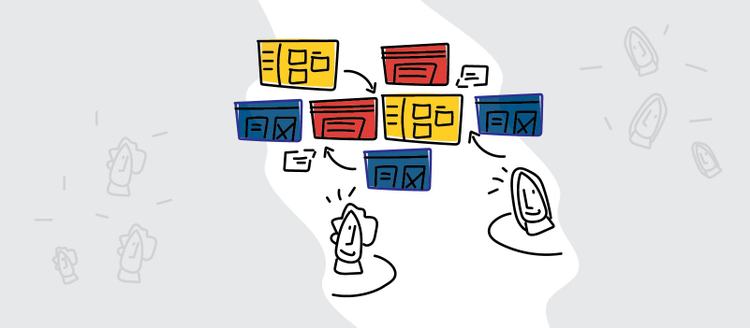Bridging the Gap in Isolation: Designer-Developer Collaboration Through Prototyping

Illustration of a designer and developer collaborating on a working prototype.
In the spirit of collaboration at Atlassian, designers and partnership marketing worked on this effort on how teams can work better together with Adobe XD and Jira.
Communication and collaboration are critical in any team’s workflow – but communication is hard and collaboration is messy. As designers, we are uniquely positioned to make sense of that mess.
By making our work visible, we’re able to bring our entire teams along the journey and ensure we’re aligned to a single vision. This transparency is now more important than ever in our new remote reality.
Working remotely has presented teams with unique challenges that not all of us are equipped to tackle. In a recent survey, only 14 percent of designers reported working remotely full-time last year.
When you’re working in a siloed environment, your team dynamics will inevitably change. One of the more visible aspects of remote collective work is misalignment among teams. If you’re collaborating on a larger project, this often translates to excessive time spent clearing up misunderstandings.
So, how are we working to prevent this at Atlassian?
We’re using prototyping as a key way to work remotely with our teams, allowing us to closely communicate with one another in a very human way. Through this common language – a magical ensemble of images, words, motion, and interaction – we can express our ideas in a way that not only allows our teammates to see our vision, but to fully experience it.
Bring everyone along on the journey
Have you ever run through dozens of static design files with your team, received a work estimate from your developers, and then had to revise your concepts and repeat the whole process over (and over) again?
Keeping everyone on the same page is not about having frequent progress updates. Instead, it’s about engaging others in the design journey. Integrating prototypes into our process has helped our teams to better build a shared understanding of how a customer will experience the solution.
“Just like a picture paints a thousand words, a prototype can paint a thousand user stories. Watch as the quality of conversations around the interactions and designs increase as you integrate prototypes into your workflow.”
Alastair Simpson, former Head of Design, Platform and Confluence at Atlassian
The more familiar your team becomes with the end-to-end journey, the more they can empathize with your customers. Prototyping takes them on that journey, sparking invaluable conversations and providing a space for ideas to intersect.
When designing, it’s easy to fall into the common trap of focusing too much on core aspects of a journey without first exploring the full end-to-end experience. Prototyping helps us avoid these pitfalls by forcing us to thoroughly understand the breadth of our customers’ interactions.
When you’ve built out a complete end-to-end journey, you’re better positioned to bring others on board to uncover new perspectives and key insights, like external dependencies and technical constraints.
Collaborate with developers in Jira on working prototypes
The best designers live and breathe customer feedback. How can you ensure you’re designing the right thing in the right way, without first putting it in front of those who will be using it?
Concept (or usability) testing is a vital part of the modern designer’s process. It allows us to validate our initial assumptions, and evolve and iterate on our original concepts.
Testing is also a fantastic opportunity to allow teammates to engage more closely with your customers. We like to share our prototype links in Jira during sprint planning, and encourage our developers to sit in and observe any upcoming testing sessions to see how customers interact with our product first hand.
Targeted in-person focus groups and sharing concepts or working prototypes to capture common themes are often used at the beginning of a design. Online research tools, that enable you to show concepts to customers for both qualitative and quantitative feedback, allow designers to further prioritize beyond directional feedback.
Streamline workflows with design integrations
When it comes to actually getting the work done, who loves context switching? No one. Sometimes, it can’t be avoided – but, it should be minimized wherever possible.
We’re all probably familiar with the following scenario: Where’s the link to the design? Which file is the most up to date? Is it called ‘final version’ or ‘latest version’?
In addition to adopting the proper file naming convention, we can also avoid the above scenario by opting for tools that support a more integrated workflow between design and development. Adobe XD’s deep integrations with Jira Software, for example, help do just that.
The Jira for XD Plugin lets designers quickly export assets, share links to designs, and associate them with Jira issues without ever leaving XD so they more easily collaborate with developers and stay focused on creative tasks. This plugin works seamlessly with the Adobe XD app for Jira, which unfurls links to XD designs to reveal rich context and provide one place to access up-to-date information. This added context helps design teams better collaborate with product managers, developers, and other stakeholders as they view XD designs from right within Jira Software.
Work together better with the right tools
As we continue to work with different teams, it’s important to find the right tools to execute with speed and adapt to change.
Prototyping isn’t just a nice-to-have anymore. It’s an essential tool that helps bring our teams another step closer to a more robust understanding of our customers’ world. And, being able to incorporate prototypes directly into our Jira workflow is a crucial advantage for our teams.
Having a seamlessly integrated workflow not only saves time but ensures that designers and developers are always on the same page as we work towards our ultimate goal of shipping value to our customers.